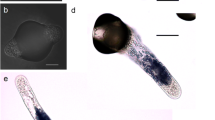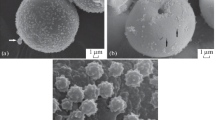Summary
In vitro penetration of the micropyle of freshly isolatedGasteria verrucosa ovules by pollen tube was monitored on agar medium. 40–60% of the micropyles were penetrated, comparable with in vivo penetration percentages. When germinated on agar,Gasteria pollen tube elongation lasts for up to 8 h while plasma streaming continues for about 20–24 h. The generative cell divides between 7 and 20 h after germination, and after 20 h the pollen tube arrives at one of the synergids. The sperm cells arrive after 22 h. The whole process takes more time in vitro than in vivo. In fast growing pollen tubes, a pulsed telescope-like growth pattern of tube elongation is observed. The formation of pollen tube wall material precedes tube elongation and probably prevents regular enlargement of the pollen tube tip-zone. Rapid stretching of the new pollen tube wall material follows, probably due to gradually increased osmotic pressure and the use of lateral wall material below the tip. The stretching ceases when the supplies of plasma membrane and excretable wall material are exhausted. Multiple pollen tube penetration of the micropyle occurs in vitro as it does in vivo. Most pollen tube growth ceases within the micropyle but, if it continues, the pollen tubes curl. Inside the micropyle the pollen tube shows haustorial growth. At the ultrastructural level, the wall thickening of in vitro pollen tubes is quite similar to that in vivo. Before transfer of pollen tube cytoplasm a small tube penetrates one of the synergids. Sperm nuclei with condensed chromatin are observed in the pollen tube and the synergid. In vivo prometaphase nuclei are found in the most chalazal part of a synergid, against the egg cell nucleus and nucleus of the central cell at a later stage. Using media forLilium ovule culture,Gasteria ovules were kept alive for at least 6 weeks. Swelling of the ovule depends on pollen tube penetration. The conditions for fertilization to occur after in vitro ovular pollination seem to be present.
Similar content being viewed by others
References
Deurenberg JJM (1977) Differentiated protein synthesis with polysomes fromPetunia ovaries before fertilization. Planta 133: 201–206
Franssen-Verheijen MAW, Willemse MTM (1993) Micropylar exudate inGasteria (Aloaceae) and its possible function in pollen tube growth. Amer J Bot 80: 253–262
Kantha K, Maheshwari P (1963) Intraovarian pollination in some Papaveraceae. Phytomorphology 13: 215–229
Li Y-Q, Bruun L, Pierson ES, Cresti M (1992) Periodic deposition of arabinogalactan epitopes in the cell wall of pollen tubes ofNicotiana tabacum L. Planta 188: 532–538
Steer MW, Steer JM (1989) Pollen tube tip growth. New Phytol 111: 323–358
Tang X, Liu G, Yang Y, Zheng W, Wi B, Nie D (1992) Quantitative measurement of pollen tube growth and particle movement. Acta Bot Sin 34: 893–898
Van Tuyl JM, Bino RJ, Custers JBM (1991) Application of in vitro pollination, ovary culture, ovule culture and embryo rescue in breeding ofLilium, Tulipa andNerine. In: de Jong J (ed) Proceedings Eucarpia Symposium: integration of in vitro techniques in ornamental plant breeding. Pudoc, Wageningen, pp 86–97
Willemse MTM, Franssen-Verheijen MAW (1986) Pollination inGasteria verrucosa (Mill) H. Duval. In: Cresti M, Dallai R (eds) Biology of reproduction and cell motility in plants and animals. University of Siena, Siena, pp 145–153
— — (1988) Pollen tube growth and its pathway inGasteria verrucosa (Mill.) H. Duval. Phytomorphology 38: 127–132
—, Keijzer CI (1990) Tracing pollen nuclei in the ovary and ovule ofGasteria verrucosa (Mill.) H. Duval after pollination with DAPI stained pollen. Sex Plant Reprod 3: 219–224
- Plyushch TA, Reinders MC (1995) Pollen tube growth and micropylar penetration in vitro inGasteria verrucosa (Mill) H. Duval andLilium longiflorum Thunb. Plant Sci (in press)
Zenkteler M (1980) Intra-ovarian and in vitro pollination. In: Vasil IK (ed) Perspectives in plant cell and tissue culture. Int Rev Cytol [Suppl] 11 B: 137–156
— (1992) In vitro fertilization: a method facilitating the production of hybrid embryos and plants. In: Ottaviano E, Mulcahy DL, Sari Gorla M, Bergamini-Mulcahy G (eds) Angiosperm pollen and ovules. Springer, Berlin Heidelberg New York Tokyo, pp 331–335
Author information
Authors and Affiliations
Rights and permissions
About this article
Cite this article
Plyushch, T.A., Willemse, M.T.M., Franssen-Verheijen, M.A.W. et al. Structural aspects of in vitro pollen tube growth and micropylar penetration inGasteria verrucosa (Mill.) H. Duval andLilium longiflorum Thunb.. Protoplasma 187, 13–21 (1995). https://doi.org/10.1007/BF01280228
Received:
Accepted:
Issue Date:
DOI: https://doi.org/10.1007/BF01280228




